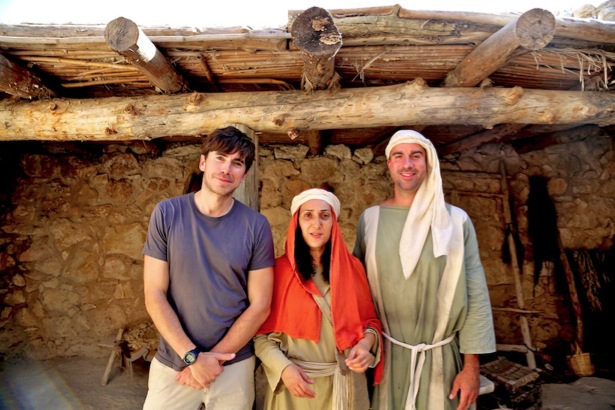DVD of Pilgrimage - now
available
PILGRIMAGE WITH SIMON REEVE
For
centuries pilgrimage was one of the greatest adventures on
earth, involving epic journeys across the country and
around the world.
This series sees Simon Reeve retrace the exciting
adventures of our ancestors. He meets inspirational modern
travellers, sees extraordinary sights and learns about the
forgotten aspects of pilgrimage, including the vice,
thrills and dangers, that all awaited travellers. He
explores the faith, the hopes, desires, and even the food
that helped to keep medieval Britons and more recent
travellers on the road.
In this series, Simon journeys first from northern England
to Canterbury. Then across France and northern Spain,
before he treks high into the mighty Alps on his way to
Rome. Finally he heads east to glorious Istanbul, Turkey,
then on to the Holy Land and his final destination,
Jerusalem.
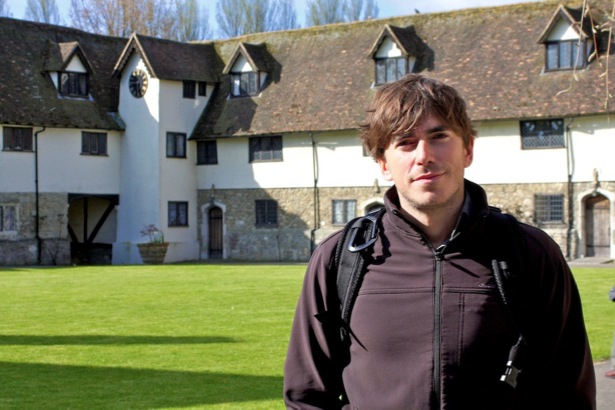
REVIEWS:
Pick of
the Day/Week in the Guardian, The Sun, Telegraph, Times,
Daily Mail, Sunday Times. The Observer, Sunday Express, The
Star
Daily
Mail: “a truly miraculous journey”
TV Times: “a truly engaging first leg…4
stars”
Daily Mail: “The excellent Simon Reeve returns with a
three-part series…illuminating, engaging and
enjoyable viewing”
Mail on Sunday: “a life-affirming new series…4
stars…”
The Sunday Times: “Pick of the Day…Simon Reeve
packs a rucksack to try to get a flavour of why the
faithful once embarked on pilgrimages and what the
experiences was like – and is like today. The Wife of
Bath would have loved him.”
The
Observer: “Choice…The BBC has had a few goes
at documentary series on this theme, but they all pale in
the face of this three-part project by Simon Reeve, a man
whose very name is a guarantee of interesting television.
He sets out to retrace the steps of pilgrims of old on a
journey from Lindisfarne all the way to Jerusalem. The key
is that Reeve is first and foremost a reporter. Despite a
Methodist upbringing, he is not a religious man and thus he
manages to remain objective throughout. In tonight’s
programme we accompany him on a 500-mile journey from Holy
Island to Canterbury cathedral, meeting fellow travellers
‘on a journey away from home in search of spiritual
wellbeing’. Outstanding.”
The
Independent: “Reeve is probably my favourite
television travelling companion, unafraid to tackle the
sometimes ugly realities behind the colourful
destinations.”
EPISODE
1
Simon
Reeve embarks on a 400 mile journey to Canterbury from the
North of England, beginning at the mystical island of Holy
Island, just off the rugged coast of Northumberland.
To reach the island, one of the earliest sites of Christian
pilgrimage in Britain, Simon follows a line of posts
marking out a crossing that emerges from the North Sea at
low tide.
Medieval Britons believed that journeys of endurance,
suffering and sacrifice to a holy site would help them find
a place in heaven. Now more than half a million visitors
make the crossing every year, mostly by car, to enjoy both
the rich history of the island and magnificent wilderness.
Travelling further south through England Simon gets to try
medieval food; marvels at the beauty and majesty of Lincoln
Cathedral, once the tallest building on the planet; and
joins thousands on an annual pilgrimage at a remote village
in Norfolk where unscrupulous salesmen used to offer
pilgrims the Virgin Mary’s breast milk.
Simon discovers the inspiration behind pilgrimge has not
always been religious devotion and piety. Pilgrimage was
often a chance for long-suffering peasants to get away from
a life of drudgery and explore their land. Many were
attracted to the road by the opportunity for adventure and
an excuse to do a little sinning away from home. There was
a world of vice to tempt travellers, evidenced by the
medieval saying ‘go a pilgrim, return a whore’.
Simon visits the area of London where brothels paid rent to
the Bishop of Winchester while tempting passing pilgrims.
He learns more about exquisite medieval travel souvenirs
that have been discovered in the muddy banks of the Thames.
Heading out of the capital, Simon meets a group of Chaucer
enthusiasts who walk the pilgrimage route made famous by
the Canterbury Tales, and gets to play the part of a
lovelorn Prince during a retelling of a Chaucerian tale in
the unique setting of a crossroads next to a supermarket on
the Old Kent Road.
Simon also meets a pilgrim who has carried a heavy
life-size cross thousands of miles, and gets to see the
700-year-old cranium of a monk while staying at an ancient
monastery.
The draw of relics – such as the blood of martyrs or
even the breast milk of the Virgin Mary - for pilgrims was
immense before Henry VIII’s Reformation, when the
golden age of pilgrim was abruptly ended. Until then
Britain’s ultimate medieval pilgrimage destination
was the site where Thomas Becket was murdered: Canterbury.
In making his journey, and discovering more about the
history and beliefs of Britain, Simon finds his attitude to
pilgrimage – and religion in general – is
profoundly changed by his encounters. This is a journey of
adventure, of celebration and of wonder. Exactly what all
the best journeys should be.
EPISODE 2
On this
second leg of the series, Simon Reeve follows in the
footsteps of thousands of travellers from previous
centuries, as he travels from northern France to northern
Spain, and then crosses western Europe to arrive in Rome.
He starts his journey on the shores of the English Channel,
meeting a British walker who’s spent nearly ten years
walking thousands of miles across the continent, and has
walked all the way to Rome and Jerusalem.
Many British and European pilgrims have been inspired by
religious devotion. But some have always been looking for
excitement, romance and adventure.
In the French town of St Omer Simon finds piles of
children’s shoes left on the tomb of a 7th century
saint with notes pleading for children to be cured of their
walking difficulties.
The pull of shrines and saints can be as powerful today as
it was for our ancestors. During the golden age of
pilgrimage in Europe, from the 11th to the early 16th
century, it’s thought that around a fifth of the
population of the continent was either on pilgrimage or
directly involved in the industry of inns and churches and
hostels that sprung-up around the routes. Simon explains
that villages near popular shrines often developed into
towns, and that pilgrimage helped to shape Europe.
To see how pilgrimage still helps to shape the continent
Simon visits a route that has come back to life and is now
one of the busiest in Europe. The Camino is a 500 mile trek
that starts in a bustling French border
town,
climbs
over the Pyrenees, winds through Northern Spain and
finishes in the holy city of Santiago de Compostela. Some
200,000 hikers and bikers completed the trek last year
alone but as Simon finds out it’s not for the faint
hearted.
Simon discovers that people walk the Camino for a host of
reasons, not just religious. He meets a tough, determined
American woman who, as a child, was caught in a house fire.
She endured 72 operations in the following nine months, and
tells Simon nothing will stop her finishing the Camino.
Simon follows the Camino route, and visits a church with a
bizarre display of live chickens, experiences the kindness
of volunteers who run hostels for hikers, meets a young
Australian couple and people who have come from around the
world, has his feet washed in a religious ritual and
savours a rare opportunity for reflection.
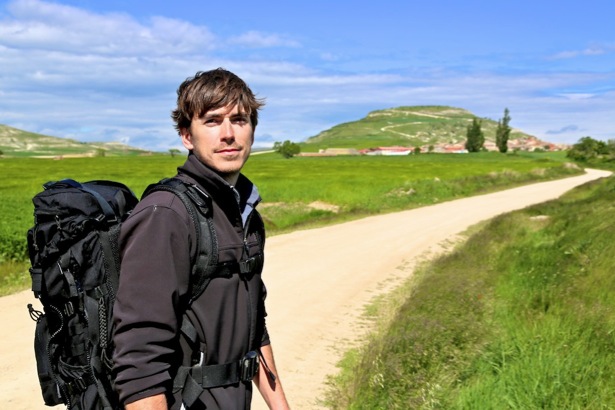
At
Compostela Simon discovers the incredible story of how the
remains of the apostle James miraculously arrived in this
remote corner of Spain in the 9th century. The cathedral
housing his remains transformed a previously obscure town
into one of
the holiest on earth. Simon meets young American trekkers
and joins the thronging crowds at the pilgrims mass for an
eye popping view as one of the biggest incense burners in
the world swings over his head.
Next Simon heads east to Switzerland and undertakes one of
the oldest and most perilous pilgrim routes in Europe. The
Great St Bernard Pass, 8000 feet high in the Alps between
Switzerland and Italy, has claimed the lives of many
pilgrims over the centuries – including at least one
Pope. Simon dons snowshoes to trek up the mountain,
arriving at a monastery and refuge at the top of the pass
that can boast it hasn’t closed its doors to visitors
for 1000 years. Also at the refuge are a group of design
students from the University of Utah. They’re
visiting European pilgrimage sites to learn about empathy.
Simon joins in their yoga class at the top of the mountain,
hears their stories, and is surprised by this very modern
mixing of cultures and religion. Nineteen-year-old Ricky
tells Simon that he wanted to make the journey because
he’s “got to get some meaning in my
life”. Then the young Americans are put to work
cleaning the monastery, and Simon watches and helps as they
as they crawl around dusting high above the altar.
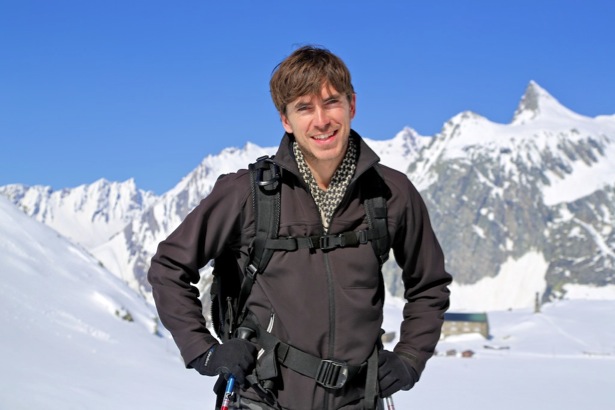
In
Western Europe there are now thought to be more than 6,000
pilgrimage sites attracting tens of millions of visitors
every year. To see how modern pilgrimage melds into tourism
Simon goes to the thoroughly modern shrine devoted to the
monk Padre Pio who died in 1968 in San Giovanni Rotondo in
the east of Italy. Padre Pio’s fame spread globally
and the economic impact on this former sheep farming town
has been massive. Rarely in the history of Christianity has
the cult of a Saint expanded so rapidly. The town now gets
2m visitors a year, and beneath the cathedral, a 75 metre
corridor is adorned with Padre Pio mosaics that promote his
legend, made from melted down gold jewellery donated by
devoted pilgrims. Simon sees the gaudy shrine, meets the
monk who runs the Padre Pio TV station, and discovers that
many modern pilgrims rather like staying in fancy local
hotels with vast swimming pools.
Finally Simon arrives in Rome and St Peters Square when
pilgrims gather in their thousands to be blessed by the
Pope. After travelling across Europe Simon has seen the
powerful effects holy places have had on pilgrims but
he’s also realised that for those who follow a
pilgrims path, it’s about what they discover on the
way and about themselves, and not just about reaching
journeys end.
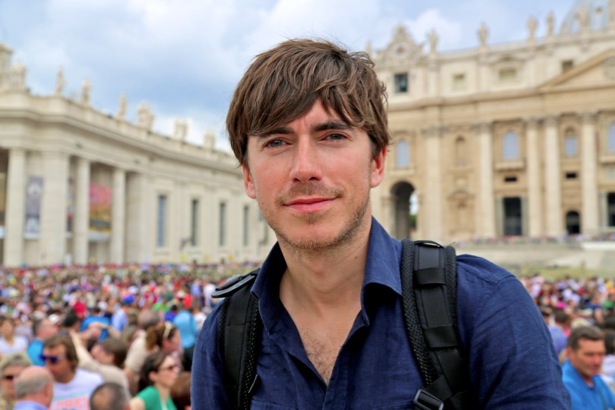
EPISODE
3
In this
final part of the series Simon Reeve follows in the
footsteps of travellers who made long, arduous and
dangerous journeys to reach the holiest place on earth -
Jerusalem.
Simon begins this part of his journey in Istanbul, Turkey,
gateway to the east, a busy medieval staging post for
pilgrims to the Holy Land. For nearly a thousand years it
was also a major destination for pilgrimage in its own
right. Simon explains that it became the centre of Roman
Christianity in the 4th century under Emperor Constantine,
who renamed it Constantinople. His mother Helena, arguably
the first pilgrim to the Holy Land, brought back relics
from Jerusalem to fill the city’s churches, which in
turn brought in scores of pilgrim’s for centuries to
come.
In the 15th century Constantinople fell to the Ottoman
Empire and came under Islamic control. Simon visits one of
the few Christian churches that survived, a building he
thinks is one of the most magnificent in the world. The
vast Hagia Sophia was converted into a mosque and is now a
museum – even today it does not fail to impress.
Simon describes how medieval pilgrims arriving in Istanbul
for the first time would have found a mysterious land where
people did things that seemed entirely ridiculous, like
washing. He visits a traditional Turkish bath, or hamam,
and gets a painful public lathering from a professional
washer. Simon winces as his joints are cracked, and
explains that in medieval Europe few people washed, but
when pilgrims began travelling through Constantinople they
rediscovered the joys of public bathing and reintroduced it
to Europe. Pilgrimage didn’t just involve the
spreading of religious ideas but very practical ones as
well.
Simon travels on to the Holy Land, following in the
footsteps of Victorian travellers who used the definitive
guide book of the period, published in 1876 by Thomas Cook
– whose grand excursions to the Holy Land pioneered
the modern package holiday.
Simon’s travelled to more than 120 countries, but
this is his first visit to the Holy Land. He drives into
the West Bank and on to Bethlehem, where he’s
astonished by the scale of the Israeli security barrier, or
separation wall. Despite not being religious he’s
moved to tears by the memory of family Christmases when he
sees the spot where Christ is said to have been born inside
the Church of the Nativity. Like travellers from the time
of Thomas Cook he then visits the extraordinary and
isolated 6th century monastery of Mar Saba - a place few
outsiders are permitted to enter today - and talks to monks
living in the middle of the desert. Simon camps in the
desert, although he suspects the Bedouin camp is a bit more
touristy than those in which Victorians slept. He’s
woken in the night by a rogue donkey, but next goes for a
spot of simple tourism, just as Victorian pilgrims did,
bathing in the Dead Sea. He also goes fishing in the Sea of
Galilee and discovers that tourist demand for the Biblical
St Peter’s fish is pushing them to extinction; then
he has an astonishing encounter with David, a reformed drug
addict who overdosed and was dying in an American hospital,
but now wears biblical clothing and lives in a village
inside the ancient town of Nazareth where people dress,
live and work as if they are characters from the Bible.
Simon helps David catch and shear sheep, and hears
David’s view of life as a modern pilgrim.
In Jerusalem, his final destination, Simon meets a doctor
who treats the bizarre ‘Jerusalem Syndrome’, a
phenomenon where visitors to the city become so overwhelmed
by the place they become convinced they personally are the
Messiah or one of the Apostles.
Several million people a year from all the three major
religions come to visit or worship in one of the most
highly contested square miles on the planet. Simon visits
the Israeli CCTV command centre where everyone is kept
under constant surveillance, and wonders whether any major
conflict here between pilgrims of different faiths could
lead to war across the Middle East.
Finally Simon joins in the ancient ritual of walking the
Via Dolorosa, the route taken by Jesus as he carried his
cross to the site of his crucifixion. The route ends at the
Church of the Holy Sepulchre, where Christ rose from the
dead. Simon reflects that the site is a witness to the
birth of a culture, of a civilization, of emotion, passion,
culture, music and suffering.
At journey’s end Simon says that even for a
non-believer, he thinks pilgrimage has much going for it,
offering a very real sense of purpose and achievement, and
he suggests more travellers should set-out to follow our
ancestors to somewhere holy and learn about the history and
the culture that shapes our lives to this day.
